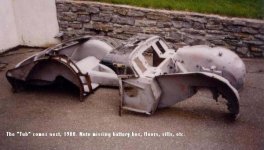Hi,
We purchased our project car part way through a previous restoration. The PO had removed the front body attachments to repair the sheet metal, but didn't reattach the plates that attach to the frame. I have found a photo of re-attached plates from a different project, and am wondering if anyone can tell me how these are, or can be attached. (The silver plates in the photo). I'm not a welder, but could be persuaded to learn if that is the only way. If so, what type of welder would I need? Any help is welcome. Thanks
 By ezgolfer1, shot with CYBERSHOT at 2008-12-14[/img]
By ezgolfer1, shot with CYBERSHOT at 2008-12-14[/img]
We purchased our project car part way through a previous restoration. The PO had removed the front body attachments to repair the sheet metal, but didn't reattach the plates that attach to the frame. I have found a photo of re-attached plates from a different project, and am wondering if anyone can tell me how these are, or can be attached. (The silver plates in the photo). I'm not a welder, but could be persuaded to learn if that is the only way. If so, what type of welder would I need? Any help is welcome. Thanks


 Hi Guest!
Hi Guest!

 smilie in place of the real @
smilie in place of the real @
 Pretty Please - add it to our Events forum(s) and add to the calendar! >>
Pretty Please - add it to our Events forum(s) and add to the calendar! >> 
